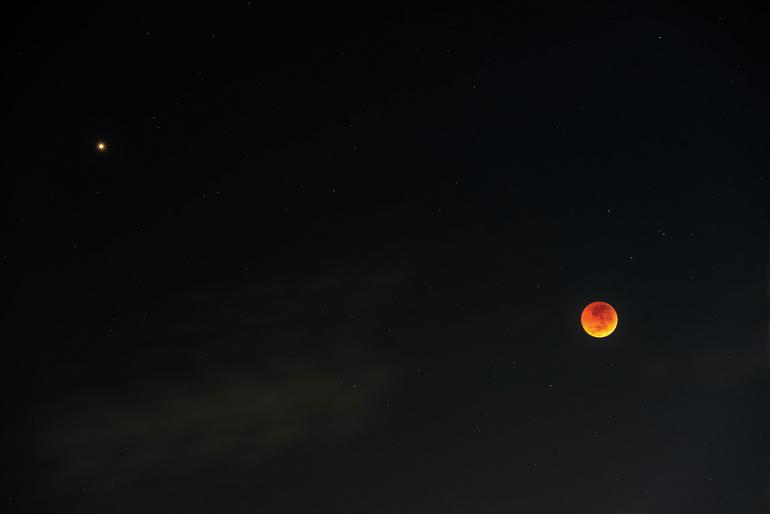Red Wedding
Our closest celestial neighbors dance in the autumn sky.
We tend to think of the night sky as a placid place, short of the sudden “shooting star” or flaming re-entry of space hardware. But the heavens can host fairly lurid events as well, and—to reference a grisly episode of a popular TV series about games and thrones—there’s a sort of “Red Wedding” in store for late fall.
One of the players is the planet Mars, shining like a drop of blood in the autumn sky, which may be what led to its association with so many grim characters. To the Babylonians, it was a manifestation of Nergal, god of war, death, and disease. To the Greeks, it was war god Ares, a destructive and disreputable fellow. The Roman Mars was more mainstream, having started out in agriculture and becoming a patron of the military-industrial complex.
The rusty planet grows brighter this fall as the Earth, in its smaller, speedier orbit, passes Mars. This bright-red speck lies in the horns of the constellation Taurus the bull, rising progressively earlier in the night, and on December 7, lies opposite the sun in the sky—at “opposition”—rising at sunset. Mars is at its closest to us then, and also at its brightest.
The dire event, popularly referred to these days as the “Blood Moon,” will occur in the early morning of November 8.
But it takes two to sky-tango, and the second player in the story is the moon—which, for its part, is often (but not exclusively) associated with female deities of generally better reputation: the Roman Diana, goddess of the hunt; the Greek Selene; the Inca Mama Killa. But it does have a regular problem: at least twice a year, it lines up with the Earth’s shadow in space and undergoes an eclipse, going briefly dark in part or in total. And when totally eclipsed, it can turn the color of Mars.
The dire event, popularly referred to these days as the “Blood Moon,” will occur in the early morning of November 8, not far from where the leering Mars sits watching. It will be a late-night (or shall we say, “Long Night”) affair, with the full moon placed high in the south at the start. The moon begins creeping into the penumbra, the faint outer part of the shadow, around 1:00 am. It starts to slide into the dark central part of the shadow, the umbra, at 2:09 am, slipping all the way in by 3:17 am. It takes nearly an hour and a half for the moon to pass through the upper portion of the umbra, stained red-orange from long wavelengths of sunlight scattering through Earth’s atmosphere into the shadow, looking lighter at the top where it is nearer the shadow’s edge.
And there you have it: a celestial “Red Wedding,” with fiery bridegroom Mars caught between the horn tips of Taurus, and bloody bride Luna sitting just to the west of the bull. Fire and blood, anyone? Roughly in between lie the Pleiades cluster (the Seven Sisters) and the Hyades—the starry “V” marking the bull’s head—as wedding guests.
The ceremony continues, as the scene tilts westward, until around 4:42 am, when the moon starts emerging from the central shadow, completing the effort by 5:49 am. It leaves the almost-invisible penumbra by 6:56 am, not long before it sets and the sun rises.
But that doesn’t end the story; after the wedding comes the honeymoon. That event is delayed until the night of December 7, the very night that Mars rises at sunset in opposition. The moon is once again full and rises with Mars between the horns of Taurus, and they engage in the ultimate celestial close encounter: an occultation.
Around 7:49 pm, with the pair in the eastern sky, the moon passes in front of (occults) Mars from our vantage point, blocking it from view. Mars pops back out on the other side about 8:54 pm.
If it’s clear, both events will be rare “must-sees” for the late fall, for even the sky can produce ratings-worthy viewing content. So bundle up, because winter is coming, and accept your invitation as the cosmos tells its stories on the dome of the autumn sky. My watch has ended.
Jim Manning is the former executive director of the Astronomical Society of the Pacific. He lives in Bozeman.














